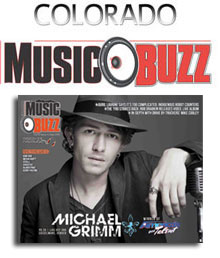The Manager’s Corner- April
by Chris Daniels
I’ve managed my own band for 31 years and I’m in the Colorado Music Hall of Fame. All that’s nice but today’s music business is changing at light-speed and you have to be more engaged in the ‘biz’ than ever. Some things have not changed, careers are still built on some tried and true elements: great music, performance and timing. But today’s artists must work harder than ever to succeed. The good news is that we have new tools to help young musicians grow their fan base. The book I wrote for the course I teach at CU Denver on artist management is called “DIY: You’re Not in it Alone.” While you are ultimately responsible for your own career, these days it’s essential to make the most of all the help that is offered along the way.
DIY album funding means that, unless your rich Aunt Sue decides to invest, you’re going to be “slapping the plastic” (a bad idea), or dive head first into the world’s most interesting new source of venture capital: crowd funding. Whether it’s Indiegogo or PledgeMusic, ArtistShare or the grandmamma of them all, Kickstarter, they all have specific rules, niche markets, dangers and advantages.
For the past five years I’ve taught the fundamentals of crowd funding at CU Denver. But I’d never run a big campaign until now. Last month I completed a successful 30-day – $15,000 Kickstarter campaign for our new album and boy-howdy was that an education for me. Probably the biggest lesson I learned is that crowd funding or ‘fan funding’ is not the right name. It should be called something like “social media fan-based engagement” (pretty awful but that’s what it is). It’s social-media based patronage AND fan-engagement like you’ve never done before! It is also not “money for nothing” – you are going to have to work your ass off for their support.
Ground rules: (a) You have to have an engaged fan base that is willing to come to shows, interact with you on social media, buy your mix tape or t-shirt at your merch booth and tell their friends about your music. (b) The number of people who contribute will be a tiny fraction of the number of people who “like” or follow you on Twitter, SnapChat, Instagram or Facebook. A safe bet is between 1% and 3%. Amanda Palmer has about 500,000 likes and roughly 4% contributed 1.2 million dollars to her record-breaking campaign. (c) Your goal and ability to achieve it has to be viable: meaning you have a project worthy of funding, a goal that is realistic when compared to your fan base and a set of rewards for your patrons that are of real value. You must also be capable of delivering the rewards and the fan-connection you promised. You have to be willing to spend time – a butt load of time – making the campaign look and sound great and function properly including all the technical aspects.
I’m going to assume that you have built a social media and/or live performance-network that is 1000 or more real fans. I am also going to assume that you understand the basic rules of social media. To review: (a) it’s not always about you – where you’re playing next, how much you like tequila, what you’re listening to today… (b) I am assuming that you are interested in what others are doing and posting and liking and sharing their posts and are “social” with them (c) I’m assuming you have a ratio of followers to people you follow that is minimum of 2-to-1 or greater and that you aren’t stupid about what you do on social media – basically, you are a pro. With that in mind here is what I’ve learned about Kickstarter that I think will be helpful.
One: the set-up is crucial; it’s time consuming and involves real creativity. I’ll use the term “programming” but it’s not the right word – there’s no coding involved. You are going to have to enter a ton of info and uploads into your campaign’s shell. You will have to keep active during and AFTER the campaign on all your chosen social media networks plus at gigs and through direct contact with family and friends. Kickstarter gives you a pretty good platform but you have to populate it with everything that matters to potential backers.
The Story: It starts with the “story.” Go to Kickstarter and search ‘music’ and look at how “stories” are done right – and how they’re done wrong (plenty of examples of both). Key elements include a video that is compelling, represents both the need for funding and your ability to follow through, and a sense of humor.
The Video: There are enough examples of good videos (and bad ones) on the site so I will not belabor that point. (My favorite is one by Steve Taylor. (https://www.youtube.com/watch?v=eiYb1PXSFvA). A video IS worth a thousand words. While it’s important to talk about the rewards in the video, the most important thing is to convey the real need and the viability – oh yeah – and make it fun!!
Rewards: The second key element is the “rewards” for backers – cool stuff they will receive for funding your project. And let me stress this again, all this programming needs to be done by you in a creative and engaging way…and it needs to be functional…there are a number of Kickstarters with broken links.
Do not over-promise. Start by setting up an entry level (“$1 to $100”) with a “no reward” option (some people want to help and don’t want anything for it). The next level should be for a $10 gift. That donation gets your backers the artist’s thanks (a hand written thank you note is cool) sent through the mail with a download card. The cost is around $.57 per download card, an envelope and a stamp. There is a section in the programing that allows you to add shipping costs and that amount is tacked onto the top of the pledge. So a $10 donation and $1 for card, envelope and stamp nets you about 10 for an $11 total donation. For $20 you get a signed CD and a thanks note – and make sure you add shipping. (Bulk bubble packs from Office Depot cost about $1.50 per unit, your CD probably cost you between $1 to $2 to replicate and bulk-rate mail is $2.50 for sending a bubble pack anywhere in the US…so charge $5 shipping and you will net $20.
From there you want to get progressively more creative. As many different offerings you can do between $30 and $200. Typical extras include CDs from back-catalogue, stickers, posters, t-shirts and more. Check out Kickstarter for examples but don’t over promise. Extras I did included a Zoot Suit, a signed guitar (went for $1,000) guitar lessons via Skype and vinyl. Again, be careful of things that are too time consuming or too costly. Don’t offer to come DJ or perform at somebody’s party unless you structure the price and the workload so that it makes sense for you – the goal is to fund the project not exhaust your resources.
Show Me The Money: Kickstarter takes 5% off the top but backers must open an account with Amazon in order to complete their transaction – and Amazon is going to take between 3% and 5% additional off every pledge for processing. Some crowd funders use Pay Pal, but it works out to be about the same. Rewards need to be set around what your fans are comfortable putting on their credit card. Don’t clutter your page with a lot of pie in the sky $1,000 or $5,000 rewards that none of your fans can afford. Have 5 rewards between $30 and $200 and forget the $5,000 reward.
Your programing will include the set up of an Amazon payment account, linked to your bank account. I used my band’s business account. Once you complete the campaign, it will take Amazon 15 days to process the funds. Once your “net” funds are available you go to your Amazon banking account to authorize a transfer. Then, Amazon will tell you that the transfer takes an additional seven days so plan on three weeks to get your money. Also essential to understand, any dead-beat backers who’s card’s can’t be billed will still have the Amazon and Kickstarter percentages taken out (even if you don’t get that money from that pledge). Kickstarter and Amazon service percentages come off the top first.
Reaching your goal is an all-or-nothing proposition with Kickstarter and some others. If my campaign had come in at $14,800 – I would get zero! There are crowd funders who don’t do that – you get what’s pledged. Why use Kickstarter or sites like it? Two reasons (1) early studies on crowd funding suggest that well designed campaigns reach their goal more often with the urgency of an “at risk” based campaign: “WE NEED YOUR HELP – WE ONLY HAVE 48 HOURS LEFT!!!” It is a huge motivator. The trend-lines Kickstarter exhibit are an initial one-week launch-surge followed by relative quiet (depending upon how active you are on social media) and a last 7-day closing-surge. (2) There is almost no reason not to make your goal if you have done your homework. How can I write that? Because, when well-managed projects get close to the end of their campaign and the project-manager sees evidence that the campaign will not reach the goal – he/she can make a pledge that closes the gap. People do this all the time. Example: A fan base contributes $4,000 to a $5,000 campaign. The manager pushes like crazy in the last 24 hours and gets to $4,800 three hours from deadline. Is he/she going to lose the $4,800 or are they going to pledge $200 that net’s them $4,500 after Kickstarter and Amazon take their 10%? It takes some subtle maneuvering, the designer cannot contribute, but it’s done all the time.
In my case, some of my fan-base dislikes Amazon. They sent me checks (almost $5,000) directly in the mail. That is legitimate support but not registered through Kickstarter. So I called Kickstarter and they showed me how to make a pledge in my check-donor names and use my credit card to cover it…that is legal and OK with Kickstarter. I have heard of some artists who have “tricked” the system by having friends pledge the “closing” amounts on cards that have a credit limit of – say $300 – and they made a $600 pledge. The campaign still showed that they reached their goal and the project was funded.
This is just scratching the surface of how involved crowd funding campaigns are. In an era when artists are going to be making albums themselves, either because they are just starting out or because they choose to go DIY, crowd funding is replacing what used to be called the “demo deal” and the “development deal” from labels. It takes thought, time and energy but you can succeed.
Category: Shop Talk






